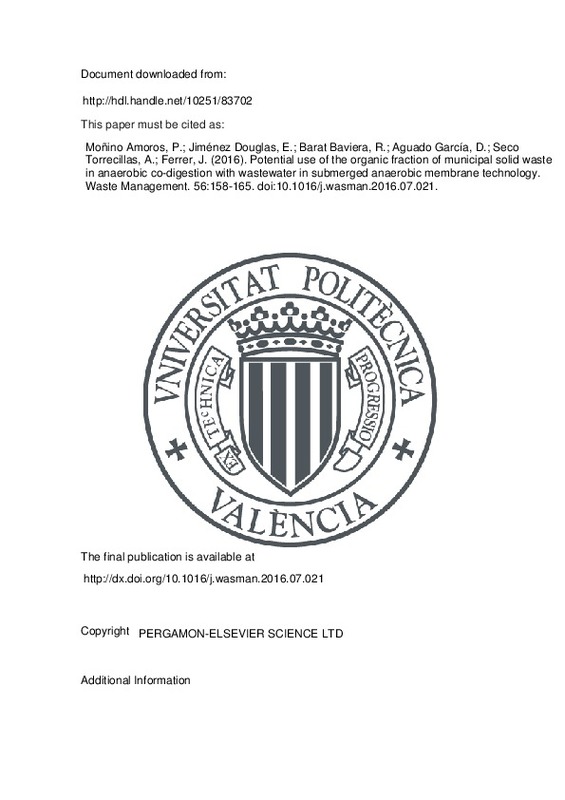JavaScript is disabled for your browser. Some features of this site may not work without it.
Buscar en RiuNet
Listar
Mi cuenta
Estadísticas
Ayuda RiuNet
Admin. UPV
Potential use of the organic fraction of municipal solid waste in anaerobic co-digestion with wastewater in submerged anaerobic membrane technology
Mostrar el registro sencillo del ítem
Ficheros en el ítem
| dc.contributor.author | Moñino Amorós, Patricia
|
es_ES |
| dc.contributor.author | Jiménez Douglas, Emérita
|
es_ES |
| dc.contributor.author | Barat Baviera, Ramón
|
es_ES |
| dc.contributor.author | Aguado García, Daniel
|
es_ES |
| dc.contributor.author | Seco Torrecillas, Aurora
|
es_ES |
| dc.contributor.author | FERRER, J.
|
es_ES |
| dc.date.accessioned | 2017-06-27T07:11:41Z | |
| dc.date.available | 2017-06-27T07:11:41Z | |
| dc.date.issued | 2016-07 | |
| dc.identifier.issn | 0956-053X | |
| dc.identifier.uri | http://hdl.handle.net/10251/83702 | |
| dc.description.abstract | Food waste was characterized for its potential use as substrate for anaerobic co-digestion in a submerged anaerobic membrane bioreactor pilot plant that treats urban wastewater (WW). 90% of the particles had sizes under 0.5 mm after grinding the food waste in a commercial food waste disposer. COD, nitrogen and phosphorus concentrations were 100, 2 and 20 times higher in food waste than their average concentrations in WW, but the relative flow contribution of both streams made COD the only pollutant that increased significantly when both substrates were mixed. As sulphate concentration in food waste was in the same range as WW, co-digestion of both substrates would increase the COD/SO4-S ratio and favour methanogenic activity in anaerobic treatments. The average methane potential of the food waste was 421 +/- 15 mL CH4 g(-1) VS, achieving 73% anaerobic biodegradability. The anaerobic co-digestion of food waste with WW is expected to increase methane production 2.9-fold. The settleable solids tests and the particle size distribution analyses confirmed that both treatment lines of a conventional WWTP (water and sludge lines) would be clearly impacted,by the incorporation of food waste into its influent. Anaerobic processes are therefore preferred over their aerobic counterparts due to their ability to valorise the high COD content to produce biogas (a renewable energy) instead of increasing the energetic costs associated with the aeration process for aerobic COD oxidation. (C) 2016 Elsevier Ltd. All rights reserved. | es_ES |
| dc.description.sponsorship | This research work was possible thanks to financial support from the Generalitat Valenciana (project PROMETEO/2012/029) which is gratefully acknowledged. | en_EN |
| dc.language | Inglés | es_ES |
| dc.publisher | PERGAMON-ELSEVIER SCIENCE LTD | es_ES |
| dc.relation.ispartof | Waste Management | es_ES |
| dc.rights | Reserva de todos los derechos | es_ES |
| dc.subject | AnMBR | es_ES |
| dc.subject | Characterization | es_ES |
| dc.subject | Co-digestion | es_ES |
| dc.subject | Food waste | es_ES |
| dc.subject | Methane production | es_ES |
| dc.subject | Resource recovery | es_ES |
| dc.subject.classification | TECNOLOGIA DEL MEDIO AMBIENTE | es_ES |
| dc.title | Potential use of the organic fraction of municipal solid waste in anaerobic co-digestion with wastewater in submerged anaerobic membrane technology | es_ES |
| dc.type | Artículo | es_ES |
| dc.identifier.doi | 10.1016/j.wasman.2016.07.021 | |
| dc.relation.projectID | info:eu-repo/grantAgreement/GVA//PROMETEO%2F2012%2F029/ES/INCORPORACION RSU AL TRATAMIENTO DE AGUAS SAMBR: ESTUDIO DE VIABILIDAD DE LA INCORPORACION DE LA FRACCION ORGANICA DE LOS RESIDUOS SOLIDOS URBANOS EN EL TRATAMIENTO DE AGUAS RESIDUALES MEDIANTE MEMBRANAS ANAEROBIAS/ | es_ES |
| dc.rights.accessRights | Abierto | es_ES |
| dc.contributor.affiliation | Universitat Politècnica de València. Escuela Técnica Superior de Ingenieros de Caminos, Canales y Puertos - Escola Tècnica Superior d'Enginyers de Camins, Canals i Ports | es_ES |
| dc.contributor.affiliation | Universitat Politècnica de València. Instituto Universitario de Ingeniería del Agua y del Medio Ambiente - Institut Universitari d'Enginyeria de l'Aigua i Medi Ambient | es_ES |
| dc.description.bibliographicCitation | Moñino Amorós, P.; Jiménez Douglas, E.; Barat Baviera, R.; Aguado García, D.; Seco Torrecillas, A.; Ferrer, J. (2016). Potential use of the organic fraction of municipal solid waste in anaerobic co-digestion with wastewater in submerged anaerobic membrane technology. Waste Management. 56:158-165. https://doi.org/10.1016/j.wasman.2016.07.021 | es_ES |
| dc.description.accrualMethod | S | es_ES |
| dc.relation.publisherversion | http://dx.doi.org/10.1016/j.wasman.2016.07.021 | es_ES |
| dc.description.upvformatpinicio | 158 | es_ES |
| dc.description.upvformatpfin | 165 | es_ES |
| dc.type.version | info:eu-repo/semantics/publishedVersion | es_ES |
| dc.description.volume | 56 | es_ES |
| dc.relation.senia | 317439 | es_ES |
| dc.contributor.funder | Generalitat Valenciana | es_ES |







![[Cerrado]](/themes/UPV/images/candado.png)

